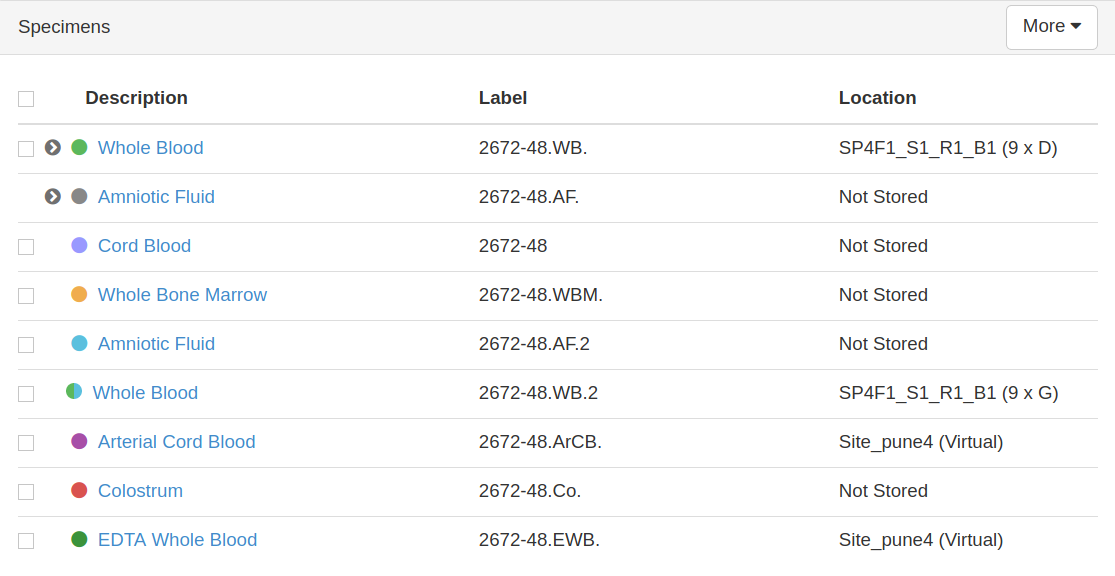| Table of Contents |
|---|
Once the protocols are set up and participants and visits collected, the next obvious step is to collect the specimens. In OpenSpecimen, ‘specimen’ can indicate a primary specimen, it’s derivative or an aliquot for storage.
You can collect specimens and visualize them in a hierarchy. In OpenSpecimen, it is called ‘specimen tree’. This model helps to track the lineage of specimens and to collect QA data like freeze-thaw cycles, centrifugation details, etc., which helps in maintaining a record of high-quality specimens.
OpenSpecimen helps to capture entire lifecycle of the specimens starting from collection, processing, storage and distribution. This page explains different features of OpenSpecimen to add specimen information in different scenarios. Below are the highlights:
- Lineage of specimens: After collection, specimens are often processed into different forms for storage. For example, Blood is collected and processed into Plasma, PBMC and Buffy Coat. In OpenSpecimen, each level can be indicated as a ‘specimen’ as primary, derivative or aliquot.
- Hierarchy of the specimens: To indicate the lineage of specimens, ‘specimen tree’ can be viewed in OpenSpecimen.
- Different status of specimen: A color-coding scheme for specimens, allows you to quickly identify the status of a specimen as to whether it is collected, stored, distributed or discarded. For more details, refer to specimen color-coding section in this page.
- Default specimen annotations: Generic details like specimen type, anatomic location, quantity, etc, are captured in default data entry pages.
...
- Custom annotations: Additional annotations like test results
...
- and pathology annotations can be
...
- captured using custom forms.
- Planned collection: For studies where what type of specimens is collected and how it is processed is known in advance, protocol can be set up with all details so that data entry is simpler.
- Unplanned collection: When specimen collection details are unknown, they can be entered as unplanned specimens.
| Gliffy | ||||||||||||||
|---|---|---|---|---|---|---|---|---|---|---|---|---|---|---|
|
This page gives an overview and links to various collection scenarios and operations on the specimens.
Collecting Unplanned Specimens
Collections for general biobanking are usually unplanned, i.e, there are no specific time-points and specimens get collected whenever they are available. For such cases, the unplanned specimen collection workflow of OpenSpecimen is best suited.
For more details, refer to Unplanned specimen collection
Planned Specimen Collection
...
For more details, refer to Planned specimen collection
Collecting Unplanned Specimens
Collections for general biobanking are usually unplanned, i.e, there are no specific time-points and specimens get collected whenever they are available. For such cases, the unplanned specimen collection workflow of OpenSpecimen is best suited.
For more details, refer to Unplanned specimen collection
Unplanned Derivatives/Aliquots
...
OpenSpecimen allows you to move the specimen from one visit to another to handle the situations like merging of multiple sub-studies, accidental collection of specimens under the wrong participant/visit, etc. This can be done across collection protocols, across participants or across the participant visits. For more details refer to Moving primary specimens from one visit to another.
Specimen color coding
OpenSpecimen displays the color code for specimens based on its status.
| Expand | ||||||||||||||||||||||||||||||
|---|---|---|---|---|---|---|---|---|---|---|---|---|---|---|---|---|---|---|---|---|---|---|---|---|---|---|---|---|---|---|
| ||||||||||||||||||||||||||||||
|
...
